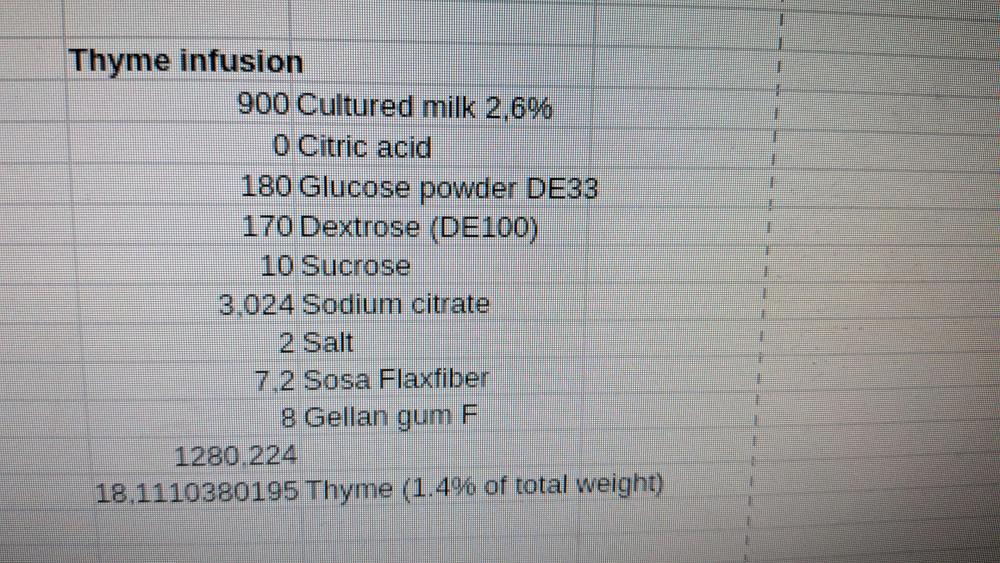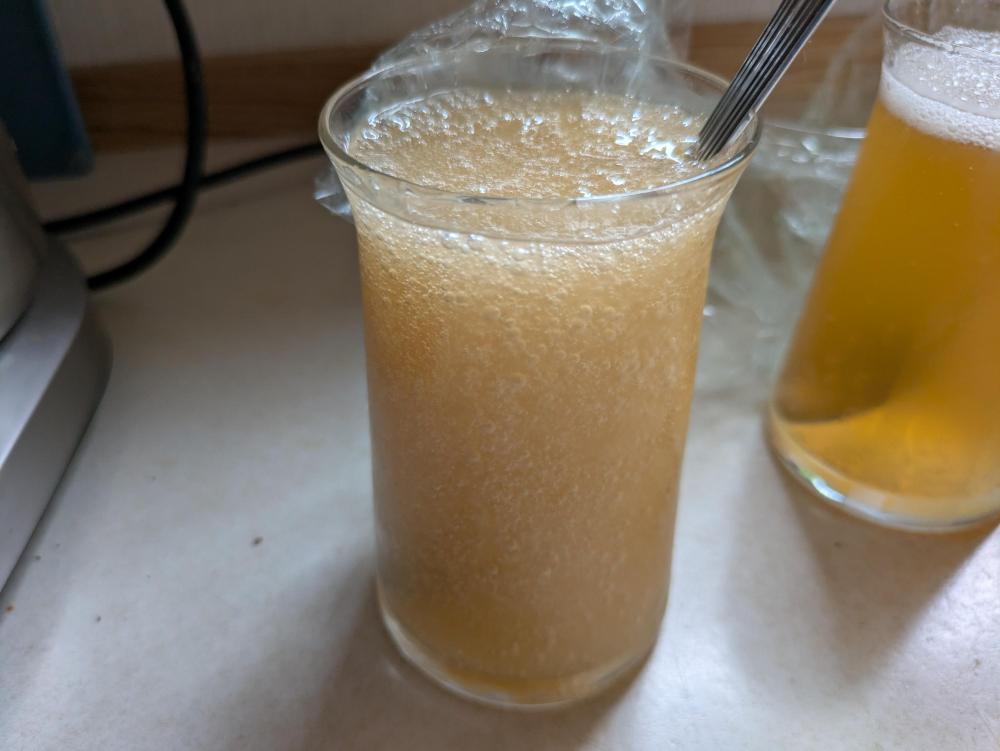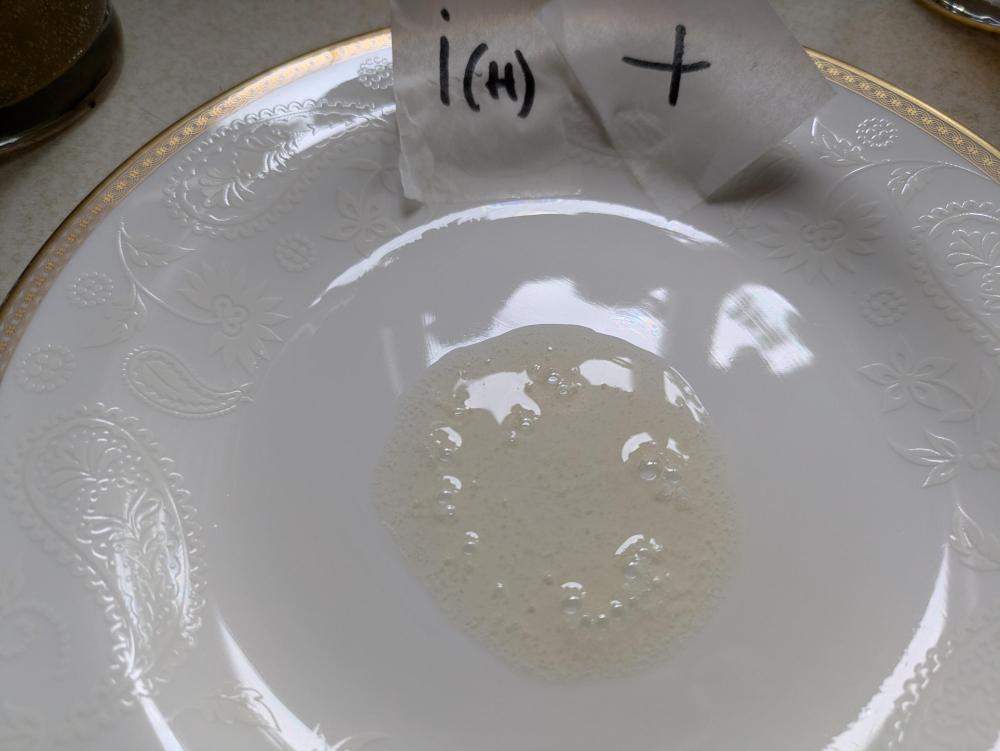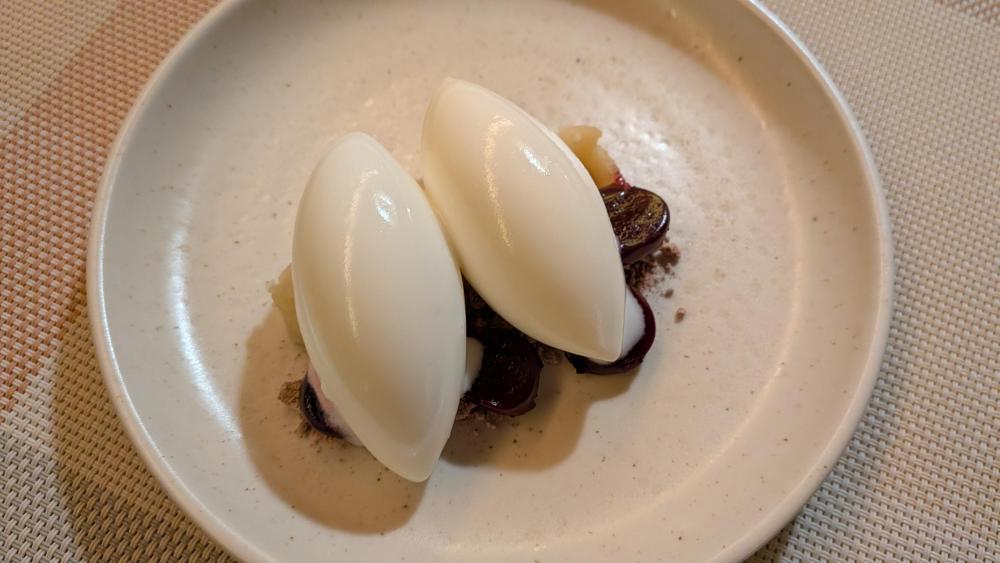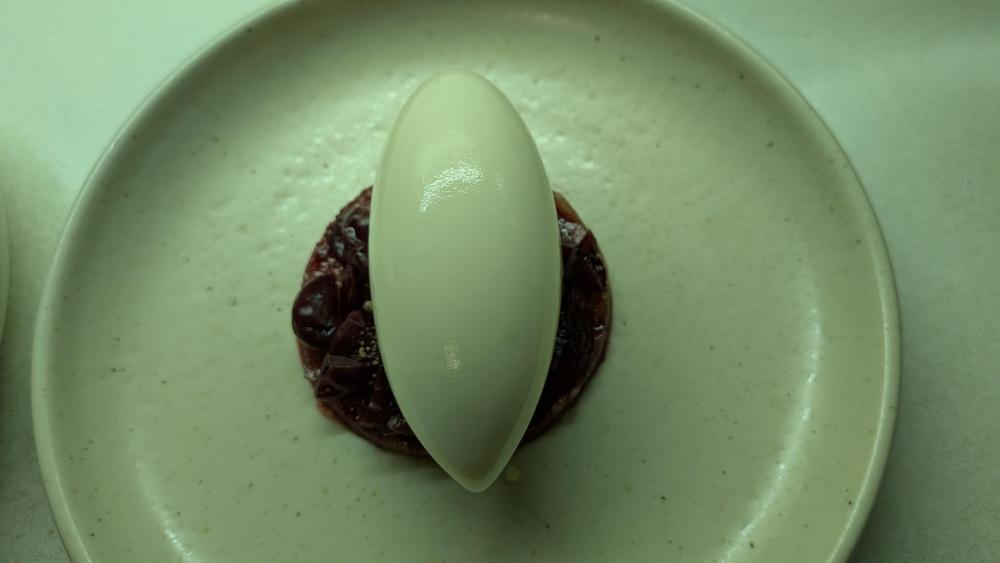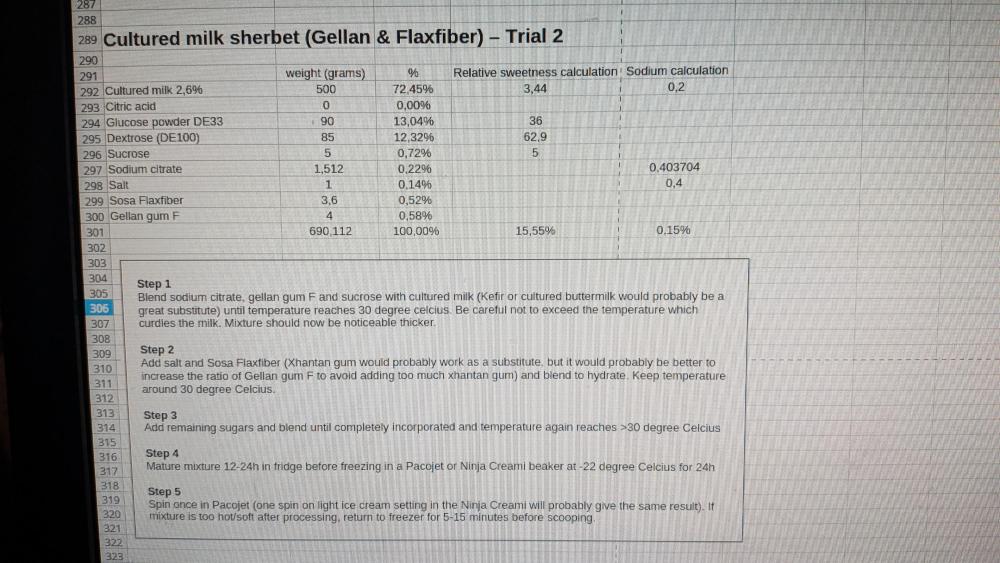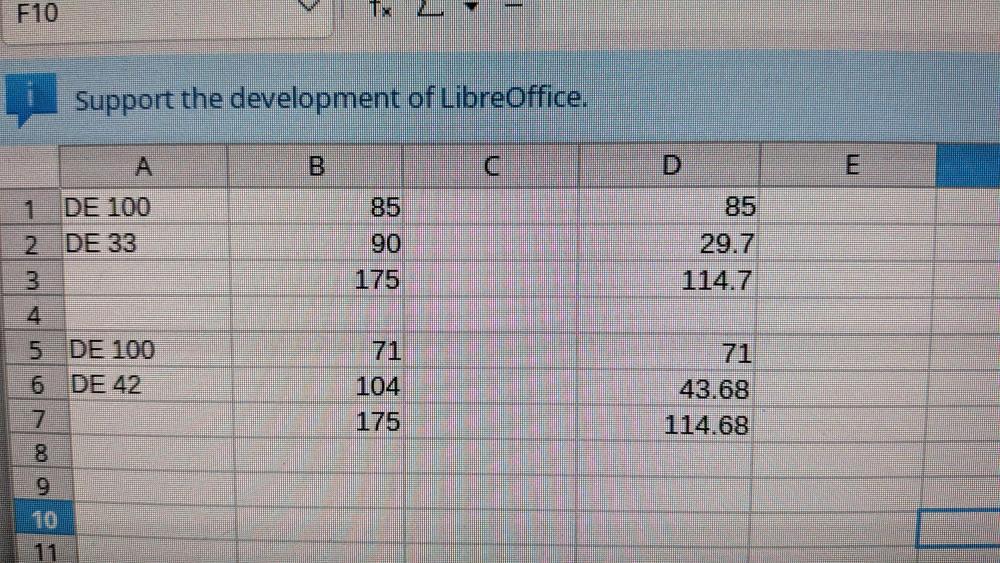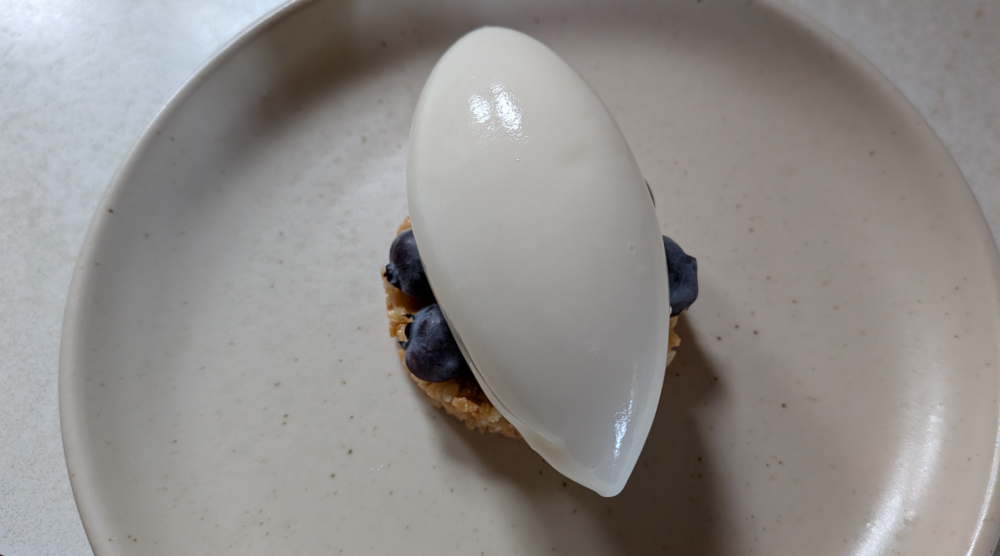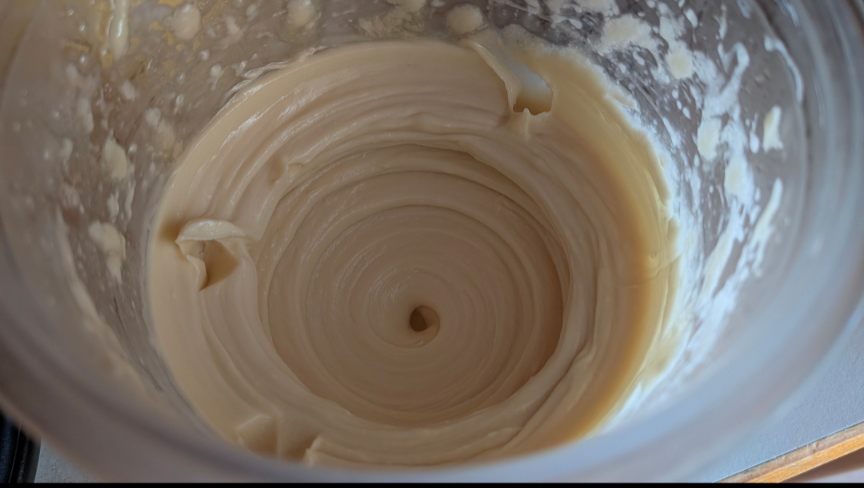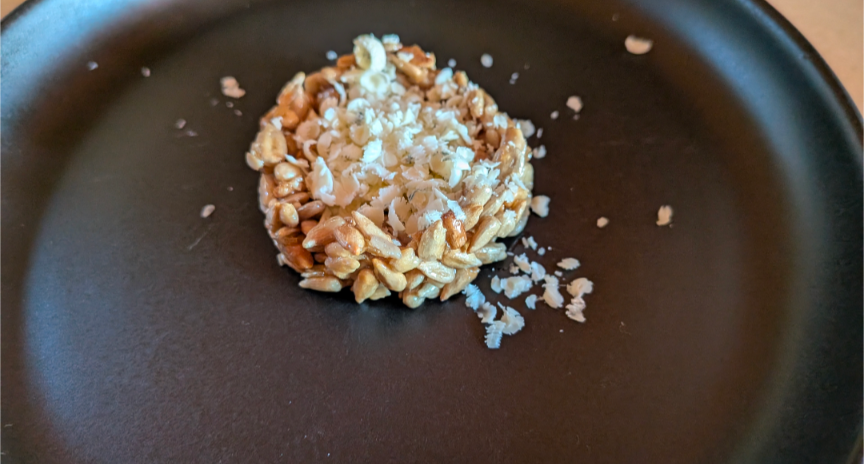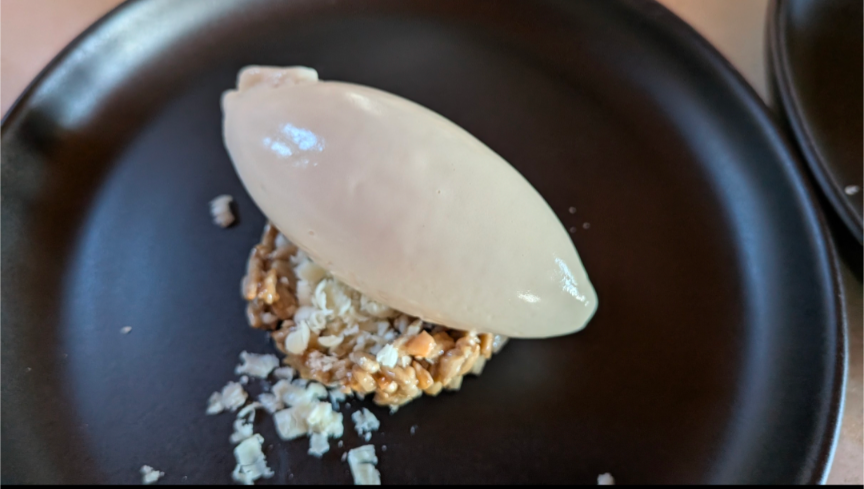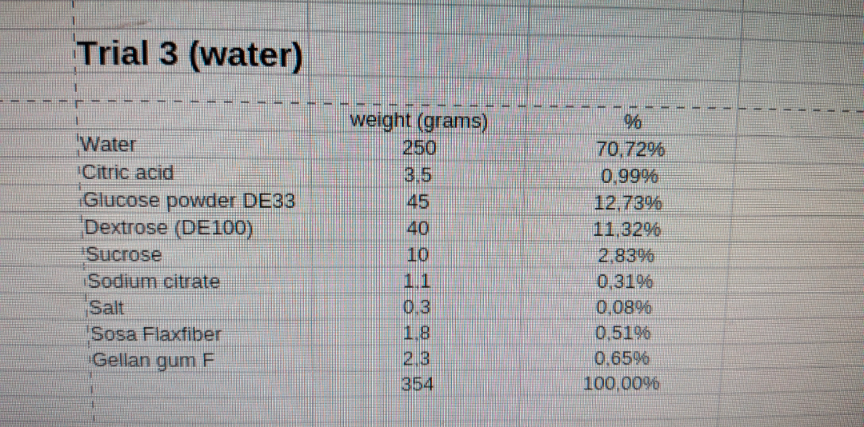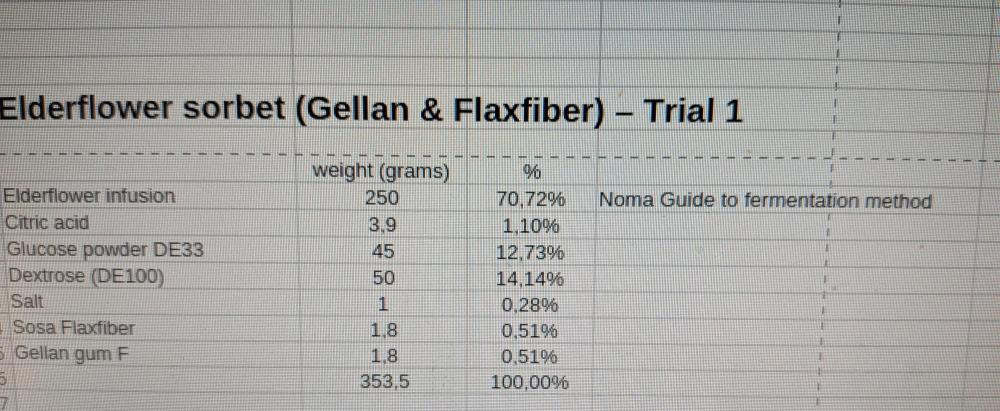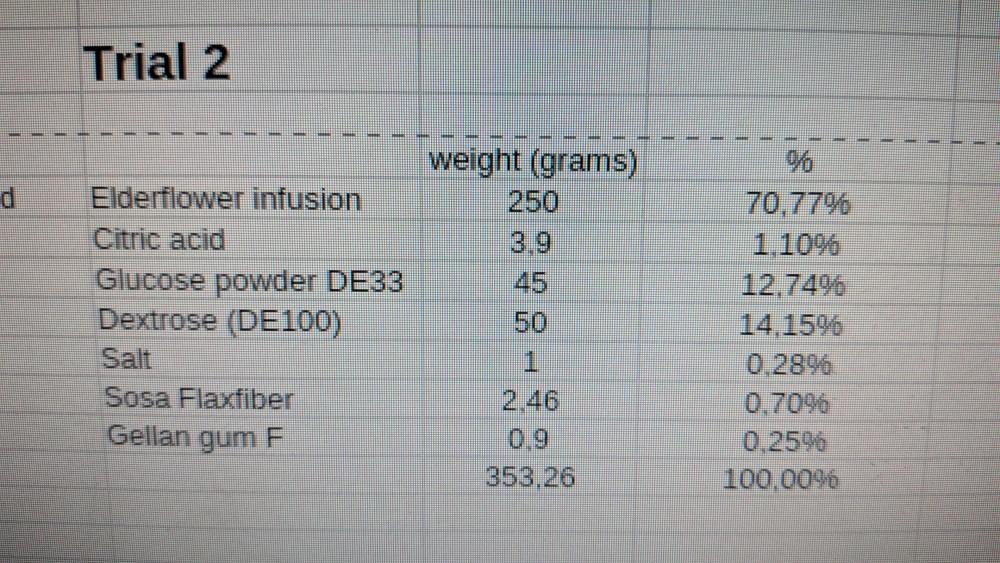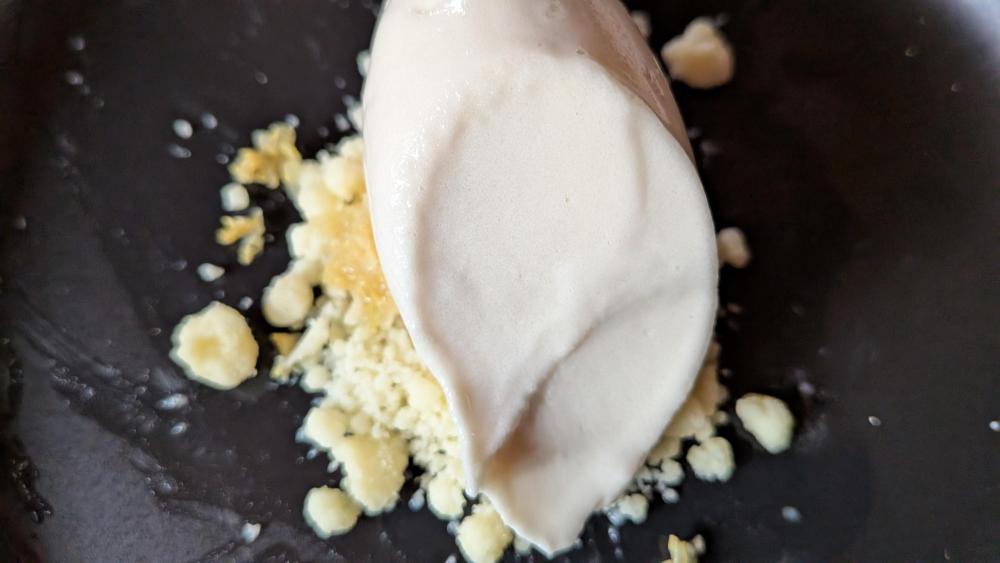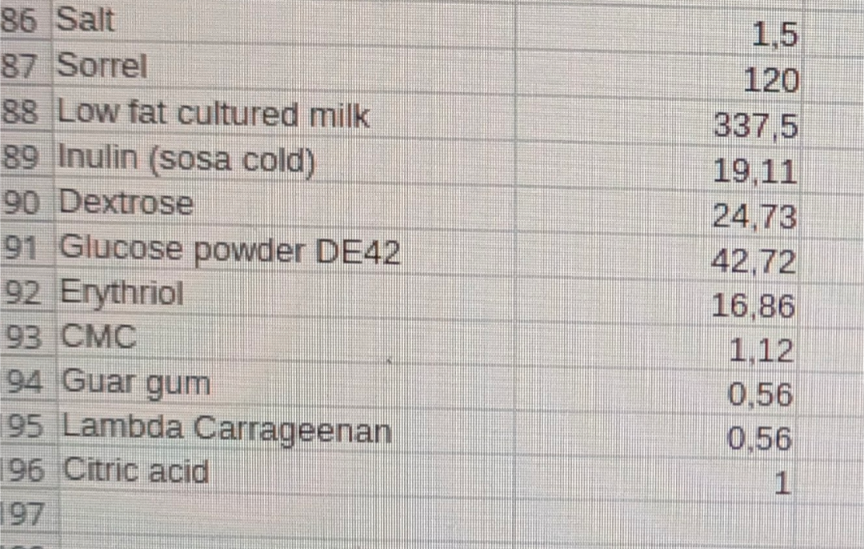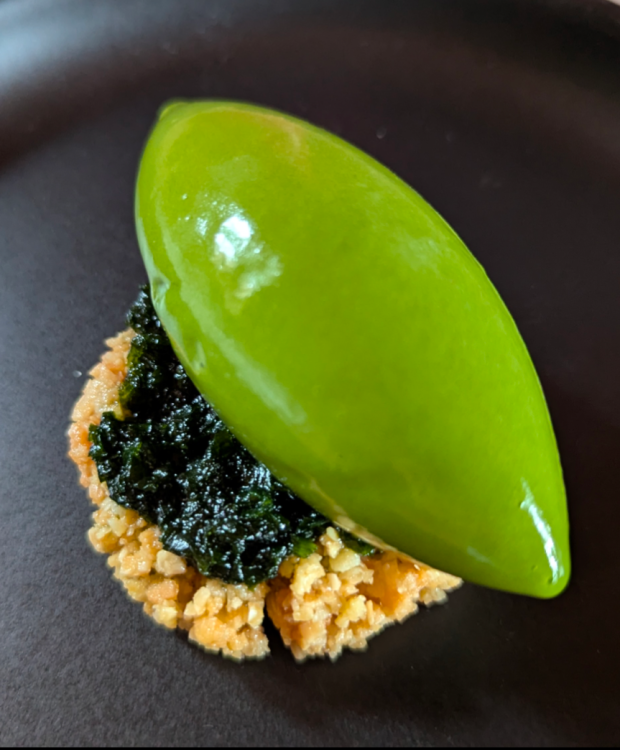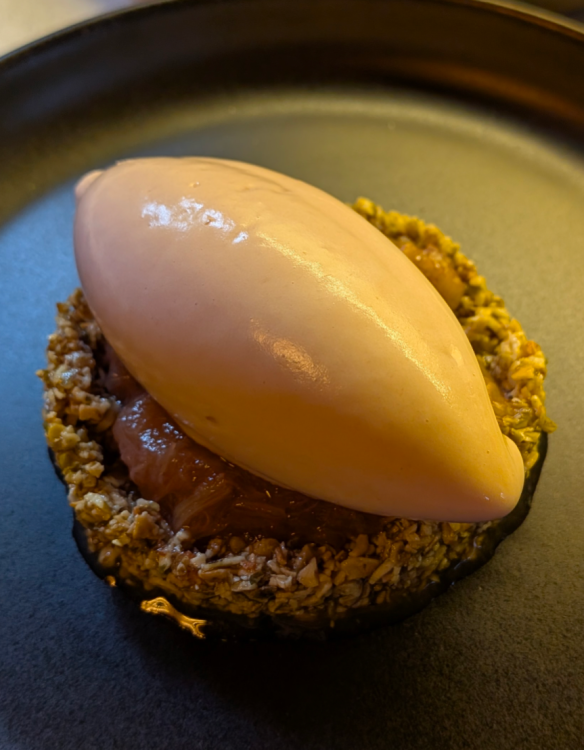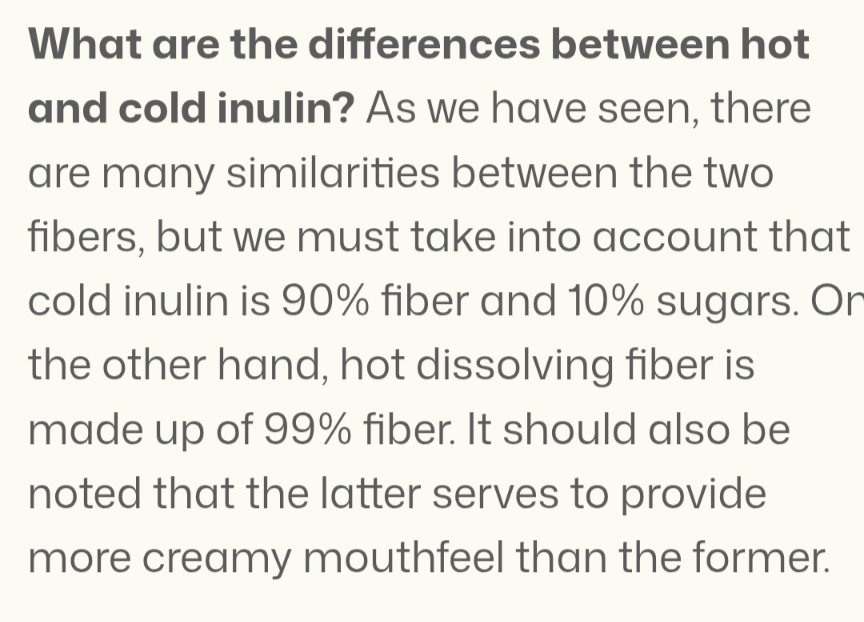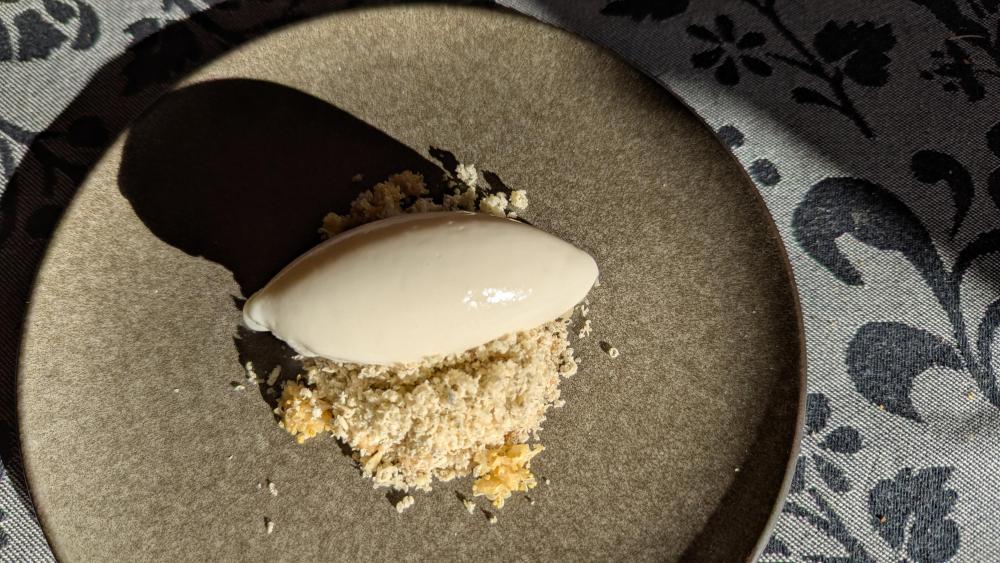
sverreef
participating member-
Posts
96 -
Joined
-
Last visited
-
@paulraphael, I'm planning to start the first tests of the Gellan/Flaxfiber sorbet recipe with strawberry instead of elderflower infusion. I don't know what types of sugars the 1% Brix of the elderflower infusion is made up of. I'm guessing that it's a mix of glucose and sucrose, but as a starting point, I'll use the same sugar breakdown normally found in strawberries, as referenced in the sample recipe on your blog. When I try to adjust and balance the recipe with the added sugars from the strawberries, would it be an advantage to add the strawberry in ICC broken down into its separate components (water, sucrose, glucose, fructose and fiber)? The plan is to start with a small batch made with Boiron puree, where the total sugar content is known from the nutritional declaration. And a second batch with clarified strawberry juice.
-
I don't know how much coumarin tonka beans contain, but I would definitely check the recipe against recommend maximum daily coumarin intake per kg body weight. I'd really like to replicate a sweet woodruff sherbet I got at a restaurant in Berlin several years ago. I even planted it in my backyard last fall, but once I started to look into the amount of coumarin in sweet woodruff, it turns out I can only add a few grams of the stuff to a whole Pacojet beaker in order to keep the coumarin at a safe level... I will still have to try it in the spring, but if the flavour of the ingredients can't be maximized due to safety concerns, it might not be worth it 🤔
-
My recent experiments with cultured milk sherbets stabilized with Gellan F and Flaxfiber has given me the perfect opportunity to try cold infusion of thyme. As a first attempt, the thyme was vacuum infused in the cultured milk for 30 minutes. The thyme flavour could perhaps be a little bit stronger, but the emphasis on the fruity and citrusy flavour notes of the thyme, as well as the complexity of the thyme flavour, was absolutely amazing. Gellan gums flavour release could be a factor in this too however. I'll have to make a batch with 1 hour infusion time next time, to see how that affects the thyme flavour, but this was without doubt another win for the gellan sorbet/sherbet approach 😃
-
They have the type of seeds which will find themselves stuck in the net of a chinois forever... I've never tried blueberries in my slow juicer, but that could be an interesting option if I need to preserve the pectin in the juice. If not, the Spinzall works wonders on the seeds. Definitely not a budget solution though 😋
-
I've completed a few tests in order to find an alternative to Flaxfiber. The candidates I tested were Inulin cold, Inulin hot (without the application of heat, so I can't guarantee proper hydration and activation, but in the past, it seems to have worked after an overnight resting period), Xanthan gum and a combination of Inulin hot/Xanthan gum. First, I did a test to compare texture change and flavour release against a Flaxfiber benchmark. To do this, I blended and hydrated the different stabilizers/emulsifiers with store bought apple juice in the same ratio I've used for Flaxfiber in the sorbets/sherbets above. Control sample: 1.8g Flaxfiber 250g Apple juice Results in a runny fluid gel like texture with little or no change in flavour compared to straight apple juice. Inulin cold: 1.8g Sosa inulin cold 250g Apple juice No noticeable texture change at this ratio, but the 10% POD was quite noticeable... Inulin hot: 1.8g Sosa inulin hot 250g Apple juice Slight texture change, but still very much a liquid and nowhere near Flaxfiber. Good flavour release. Xanthan gum: 1.8g Xanthan gum 250g Apple juice It looks like Sosa may have reversed the Flaxfiber to Xanthan gum replacement ratio because this resulted in a thick nasty goop. 0.9g might have worked better, but I went for another option. Inulin hot and Xanthan gum: 1.4g Inulin hot 0.4g Xanthan gum 250g Apple juice Very close in texture and fluidity. Good flavour release, but interestingly, it highlights and exaggerates the acid in the juice rather than the fruit. Still, this was enough of a success to proceed to a full cultured milk sherbet trial: Same recipe as above, but 3.6g Flaxfiber was replaced by 2.8g inulin hot and 0.8g Xanthan gum. Inulin should be added together with Gellan gum, sodium citrate and sucrose. Version with Flaxfiber on the left and inulin/xanthan on the right. Both very good, but a couple of minor differences. The inulin/xanthan version is slightly softer and melts a bit too quickly on the tongue for my liking (they are both very stable on the plate though, probably thanks to the gellan gum). It's also more acid forward in flavour, but that could be partly because of milk from different cartons/production dates. If I didn't have Flaxfiber, I would definitely experiment more with this. I would probably try to increase the amount of inulin and/or xanthan a bit though.
-
Possibly. The reason I mentioned xanthan gum is that Flaxfiber supposedly was made to be a xanthan gum replacement used in a 1:2 ratio: https://www.sosa.cat/en/producto/flaxfiber/ Given Flaxfibers fiber content, Inulin, or a mixture of inulin and xanthan gum may be a better substitute for an ice cream/sorbet base however. I guess I'll have to set up a side by side test to see how the alternatives compare to Flaxfiber.
-
Test 2 of the cultured milk sherbet fixed the slight texture issue of test 1, so I think it's now good enough to share the recipe: Sorry for the horrible photo light... Served with marzipan soaked in the juice from fermented cherries, fermented cherry pieces and dark chocolate crumbs. I know that Flaxfiber is a pain to source, but hopefully, someone else will be inspired to try this method and share their results to further its development. I mentioned xanthan gum as an alternative to Flaxfiber under the recipe, but lambda carrageenan could probably also be an alternative? Glucose powder with DE42 is probably easier to source for the majority of you. I don't have more DE42 left myself to test it, but with other recipes in the past, I've been able to switch between DE33 and DE42 glucose powder without noticeable issues. I've just made a simplified conversion of the ratio of dextrose and glucose powder in order to keep the combined DE value of the two sugars consistent. Something like this: My next attempt will probably be strawberry or rhubarb (might be too acidic for Gellan gum to work), but my stock of glucose powder is almost empty, so it may take a little while before I get a chance to try that.
-
In order to preserve my remaining pantry of elderflower infusion until I have the recipe dialed in, I decided to try the low acyl gellan gum cold hydration and Flaxfiber approach with another falvoured liquid (and a few other minor tweaks). The result is a cultured milk (2,6% milk fat) sherbet: The flavour was bright and refreshing, with just the right balance between sweet, salt and the tang from the cultured milk. "Rocherability" after one spin in the Pacojet was close perfect too. It could perhaps benefit from a slightly more creamy mouth feel though, so I'll try to increase the amount of Gellan gum from 0.51% to 0.55% next. A small addition of skim milk powder could also be worth a test. If I manage to dial this in perfectly, and provided that cold vacuum infusion can deliver the right thyme flavour, this may end up as my new preferred base for thyme "ice cream".
-
Good news. Low temperature hydration of Gellan F is definitely possible 😀 In fact, the addition of sodium citrate worked almost too well... Still, the Elderflower sorbet had perfect scooping consistency after two spins in the Pacojet. I paired it with a base of roasted sunflower seeds (flavoured and bound together with salt, honey and glucose syrup) and grated frozen blue cheese. Very, very close, but for a sorbet, I actually found it slightly too "creamy". Gellan proves its reputation as a bit finicky, but its amazing flavour release and promising results on consistency, is definitely worth further testing. With some minor tweaks to the gellan and sodium citrate amounts, the elderflower sorbet might be dialed in perfectly 🙂 and then I can move on to other flavors. Adding all the sugars (and salt?) before hydrating the Gellan gum, as opposed to after like I did in this test, may have an impact on the result too. For those interested, the elderflower infusion I used had a Brix of 0.9%.
-
My previous experience with Gellan gum has been limited to a few fluid gels using recipes from Chefsteps and the Modernist Pastry blog, so I was under the impression that low acyl Gellan gum needed close to boiling temperatures to hydrate properly (at least for parts of the liquid you want to "gel"). This isn't ideal for heat sensitive fruit juices, but luckily, the technique to preserve the fresh fruit flavour in Chefsteps' orange fluid gel is a good workaround. While I was searching the internet for information about gellan gum in sorbets/ice cream, I stumbled across the information about hydration temperature on page 6 in the "Gellan Book" however: https://www.scribd.com/document/153670720/Gellan-Book-5th-Edition If I understand this correctly, it seems like it could be possible to hydrate the Gellan gum in a sorbet base by adding sodium citrate and blending the base (or at least parts of it) until the temperature reaches only about 30-ish degrees Celsius... Has anyone tried this with low acyl Gellan gum before? If not, I guess I'll have to be te guinea pig with my next trial. Something like this maybe?
-
I mentioned Sosa Flaxfiber as a potential stabilizer/emulsifier earlier in the thread, and now I've finally had a chance to play around with it in a couple of small Elderflower sorbet trials. In addition, I had a chat with the pastry chef at a restaurant l visited this summer, and he recommended Gellan gum as a sorbet stabilizer, so I decided to wing it and combine the two: Both trials spun once in the Pacojet, and both batches were surprisingly successful. Absolutely mazing flavour release, especially trial 1 (I didn't taste them back to back however, so the comparison was done by memory one week apart), and the texture/mouth feel was really good too. Definitely something worth further investigation with minor tweaks to the Flaxfiber/Hellan gum ratios. In future trials, I will probably substitute a few grams of dextrose for sucrose in order to reduce the freezing point depression slightly (ca. 1 degree C increased serving temperature). I've already tweaked the sugars for trial 3 in ICC, but I can't remember the exact numbers. A small addition of inulin and lambda carrageenan would also be interesting to try in order to find the perfect compromise between flavour release, mouth feel and melting rate/plated stability... I also can't wait to try this alternative approach with strawberry juice and/or puree for a direct comparison to my version of Paul's strawberry sorbet recipe tweaked for the Pacojet/Ninja Creai.
-
A couple of recent successes I've had using this approach: Sorrel sherbet (sorrel added Lauren Eldridge style) On its own, it could have been a touch sweeter, so I might replace 4-5 grams of the cultured milk with fructose next time. When I paired it with "sorrel sugar", seen between the almond crumble and the sorrel sherbet, it balanced quite nicely however 🙂 Modernist Cuisine Sour Rhubarb sorbet variant I had just enough DE42 powder left for this batch (57 grams), so the the DE33 conversion is just something I'll try in the future, since DE33 powder is easier to buy for me. Served with roasted pumpkin seed crumble (made with the Pacojet coupe set) and rhubarb compote. Like the sorrel sherbet, it could probably be slightly sweeter, but I'll have to compare the relative sweetness between this and the original MC recipe in Ice cream calculator to see how they match up. As you probably can tell from the picture, the texture was phenomenal though.
-
Thanks for highlighting this interesting technique. I'll probably try to use it for a sweet woodruff (Galium odoratum) ice cream. I haven't checked the plant I planted in my garden last fall in a while though, so if it has already flowered, the project might have to wait until next spring... I had a wonderful sweet woodruff sherbet at a restaurant in Berlin several years ago, so I hope to be able to replicate that flavor. I worry that the recommended maximum safe amount of 3,5 grams per liter won't be enough of the herb to highlight the sweet woodruff flavour however, but I'll never know until I try it. Do you (or anyone else) have any experience working with this herb?
-
Sherbet is probably the right classification for it. Lactic acid fermented cultured milk (2.6% fat) and cultured skim milk are traditional staples here in Norway. Similar to buttermilk, and as far as I know, the main reason buttermilk isn't available in Norwegian grocery shelves. Sosa has two types of insulin. I recently got hold of the cold version too, which hydrates easier without heat, but I used the hot version this time, since I didn't want to change too many variables from the strawberry version I made when I only had the hot dissolving version. https://www.sosa.cat/en/product/hot-inulin/ In some places Sosa claim that the hot version must be heated, but in other places, it is only mentioned as a recommendation, and cold dispersion /hydration (over night) seems to work OK for me. If I remember correctly, Sosa has a recipe on their website with cold dispersion/hydration as well, but I can't seem to find it on my phone at the moment.
-
In the past, I've had some success with adding elderflower infused water to the Chefsteps Creme Fraiche ice cream recipe, but it's been a challenge to maximize the elderflower flavour as much as I would like. Therefore, I got really excited by the result I got with strawberry juice and Paul's sorbet recipe, and now I've finally had the time to test it: 112.5g Cultured skim milk (0.4% milk fat) 498g Elderflower infused water (sweetened to 8 Brix) 25.5g Inulin (Sosa inulin hot) 33g Dextrose 57g Glucose powder DE42 22.5g Erythritol 1.5g CMC 0.75g Guar gum 0.75g Lambda carrageenan 0.75g Salt 2.5g Citric acid Spun two cycles in the Pacojet, and the result was close to spot on. Smooth and creamy mouth feel with a bright and clean elderflower flavour. Next time I'll try to double the amount of salt to see how that impacts the flavour. The milk also floated to the top of the beaker during the freezing process, so I'll probably add some flaxfiber in an attempt to stop that from happening. The separation isn't really a big issue as long as I spin the whole beaker, but it would be nice to have a stable mixture, so I have the option to spin only a few portions at a time.


